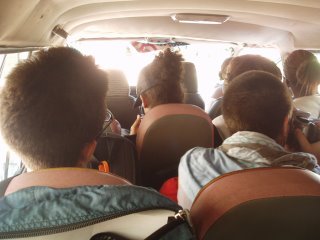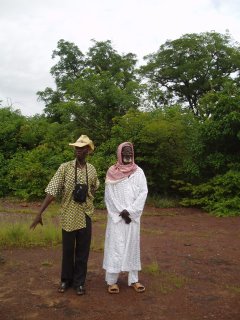A typical afternoon drive in Mali
Do you remember 2nd grade field trips to the zoo? The kind where your teacher gives each parent volunteer a detailed packet that includes, but is not limited to an itinerary, map, and list of each kid’s allergies. You’d climb into someone’s suburban or minivan and proceed to watch some Disney film to past the time all while seated comfortably in pilot seats. Well, let me be the first to tell you that field trips in Mali bear no resemblance to those elementary school forays (surprising, I know). Allow me to elaborate:
Our Malian culture and history lectures have thus far been focused on the Sunjata epic that explains the origin of the Malian empire in West Africa. The story has near Biblical importance as it lays out a code-of-conduct for Malian society. It was decided that we would visit the historic village of Kangaba where the sacred texts of this story are kept and recited every seven years by griots (oral historians). What was only supposed to be a two hour drive from Bamako ended up lasting four and a half hours and forcing us to spend the night in this rural village. It’s your typical story of driving in Africa, one that was painful at the time, but funny and memorable while looking back.
To better explain why it took so long, I first have to make clear that we are in the midst of the rainy season here in Mali. This is great because it keeps the temperatures relatively cool (80’s) and the dust down, but it also means that red dirt roads get completely destroyed. And I use the word “road” very loosely because 1) the highway that we took wasn’t paved, 2) they’re pocked not with potholes, but rather small craters, and 3) when water is added, they become the consistency and color of baby poo. As someone from the motor city, I can confidently say that I’ve never seen such roads in disrepair. Because each driver avoids the gaping holes and pools of water, the “two-lane road” is reduced to a winding single track with deep ruts. Streams and rice fields spill over as if the road didn’t even exist. It’s not an exaggeration when I say we often drove through rivers deep enough to have water splash up through the cracks in the van’s floorboards.

The vehicle itself was probably the single cause of discomfort on the trip. 19 of use were crammed in an 18 person van and each seat was about 80% the width of your butt. No matter where you sat, you were in pain. Window seats had good views and ventilation, but the plexiglass rattled like a machine gun and your shoulder was constantly being dislocated as the van thrashed around. Personal space simply did not exist and your legs reached a level of pain so great that you mentally reached a level of disassociation from your body.
Perhaps the hardest part was that we didn’t know how much longer it would last. We stopped for a bathroom break along the road (and by bathroom, I mean the ditch along the road) and asked for directions. We were told 3 more km and our hopes soared at this good news and then crashed as we realized it was really 33 km and another hour and a half.
Through it all, everyone’s attitude was amazing. We were stuck together for an undeterminable amount of time so we might as well be laughing about the situation. Singing and telling jokes with horrible puns passed the time quickly as did waving to all the children that we passed on the road (lots of little kids herding goats and donkeys).
We finally reached Kangaba around dusk and as local custom demands, we met with the local mayor. Part way through his welcome, we were interrupted by his cell phone and it was only slightly jarring to hear a ring tone in what we thought was a rural community. He told us it was too dark to visit the sacred sites and too late to hire a griot to act as a guide. Fortunately, the village had a “hotel” and we were able to get rooms for the night (remember, we had only packed for an afternoon trip and all had awful morning breath by the next day, among other things).

We ended up seeing the places we had read about in our books, something we rarely are able to do in school, but honestly, we were a little too tired and a little too rushed to enjoy it. Plus, the prospect of the return 4.5 hour drive weighed heavily on all our minds. The drive was just as uncomfortable as the first half, but at least we were mentally prepared for it. We realized in the days that followed that our pain threshold for Malian driving had significantly increased and that the group bonded through such an experience. It almost seemed like the drive itself was the lesson…either that, or we were being filmed for Punked or Candid Camera. I have video of a lot of the trip and I look forward to sharing our increased stages of travel delirium.

0 Comments:
Post a Comment
Subscribe to Post Comments [Atom]
<< Home